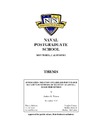A predictive analysis of the Department of Defense distribution system utilizing random forests
| dc.contributor.advisor | Buttrey, Samuel E. | |
| dc.contributor.author | Coleman, Amber G. | |
| dc.date | 16-Jun | |
| dc.date.accessioned | 2016-08-02T19:34:41Z | |
| dc.date.available | 2016-08-02T19:34:41Z | |
| dc.date.issued | 2016-06 | |
| dc.identifier.uri | https://hdl.handle.net/10945/49436 | |
| dc.description.abstract | This thesis develops machine-learning models capable of predicting Department of Defense distribution system performance of United States Marine Corps ocean requisitions to the United States Pacific Command area of operations. We use historical data to develop a model for each sub-segment of the Transporter leg within the distribution pipeline and develop two different models to predict the ocean transit sub-segment based on Hawaii and non-Hawaii destinations. We develop a linear regression, regression tree and random forest model for each sub-segment and find that the weekday and month in which requisitions begin the Transporter segment are among the most significant drivers in variability. United States Transportation Command currently uses the average performance per sub-segment to estimate Transporter length, and our models, when applied to the test set, perform considerably better than the average. We conclude that the random forest models provide the best and most robust results for most sub-segments. However, we encounter several issues concerning missing values within our dataset, which we suspect artificially inflate the significance of some of our predictor variables. We recommend refining data collection processes in order to collect observations that are more accurate and applying the same methodologies in the future. | en_US |
| dc.description.uri | http://archive.org/details/apredictivenalys1094549436 | |
| dc.publisher | Monterey, California: Naval Postgraduate School | en_US |
| dc.rights | This publication is a work of the U.S. Government as defined in Title 17, United States Code, Section 101. Copyright protection is not available for this work in the United States. | en_US |
| dc.title | A predictive analysis of the Department of Defense distribution system utilizing random forests | en_US |
| dc.type | Thesis | en_US |
| dc.contributor.secondreader | Alt, Jonathan K. | |
| dc.contributor.department | Operations Research | |
| dc.subject.author | Department of Defense (DOD) distribution | en_US |
| dc.subject.author | linear regression | en_US |
| dc.subject.author | regression trees | en_US |
| dc.subject.author | random forests | en_US |
| dc.subject.author | machine learning | en_US |
| dc.subject.author | ocean shipments | en_US |
| dc.subject.author | predictive models | en_US |
| dc.subject.author | United States Transportation Command (USTRANSCOM) | en_US |
| dc.subject.author | Marine Corps Logistics Command (MARCORLOGCOM) | en_US |
| dc.description.service | Major, United States Marine Corps | en_US |
| etd.thesisdegree.name | Master of Science in Operations Research | en_US |
| etd.thesisdegree.level | Masters | en_US |
| etd.thesisdegree.discipline | Operations Research | en_US |
| etd.thesisdegree.grantor | Naval Postgraduate School | en_US |
| dc.description.distributionstatement | Approved for public release; distribution is unlimited. |
Files in this item
This item appears in the following Collection(s)
-
1. Thesis and Dissertation Collection, all items
Publicly releasable NPS Theses, Dissertations, MBA Professional Reports, Joint Applied Projects, Systems Engineering Project Reports and other NPS degree-earning written works.





